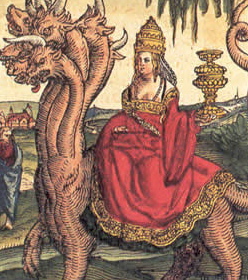The Popess: A Female Pope? April 28, 2012
Author: Beach Combing | in : Medieval , trackbackThere are popes who had children, there are popes who took part in orgies, there are popes (at least one) who did not believe in God. However, Beachcombing has so far avoided the most remarkable pope of all: Pope Joan. The story is quickly told. Pope John VIII went out to bless the people of Rome after a locust storm in 854. However, between the Vatican and S Giovanni in Lateran, the Pope was struck with stomach pains. He fell down and at this point it became apparent that Pope John was actually a Joan and that she was about to give birth. The crowd was so infuriated that they fell upon the false pope and, Romans being Romans, tore Joan and the new born child to pieces.
Women do spend years successfully pretending to be men so there is nothing inherently impossible here. However, make no mistake, this little tale is cobblers: there was no John or Joan between Leo IV and Benedict III, which the dating of the story probably demands (there is a minor controversy about its chronology). The first sources comes some two centuries after the events and include Sigisbert of Gembloux (obit 1112) and Mariannus Scottus. From there the material grows through several generation into the Marchen described above: Joan appears in Boccaccio and Luther (who was scandalised about a statue of Joan in Rome).
So what is the explanation for this extraordinary story that might, incidentally, have given us the ‘Popess’ in the pack of tarot cards (pictured above)? Our sources are just too slight to base proper hypotheses off. However, there are three facts that run together. First, the early tenth century, when this story was, Beach would assume, maturing orally, was the period of the ‘pornocracy’ or government by whores in Rome: when popes had sexual relations with women of easy repute who dominated the Papal government: ‘women on top’. Second, John VIII who died in 882 seems to have been effeminate and to have been mocked as such by the population: or was this effeminacy posited on him by an attempt to transfer the legend? Third, the legend developed in a period of growing tensions between the Pope and the rulers of Germany: this story was useful ammunition in the context of the growing war of words that would end at Canossa. Any other explanations? drbeachcombing AT yahoo DOT com
Of course, what Joan has given the modern world is a Catholic Orlando without Virginia Woolf’s chewed up prose and naturally Joan has starred in several books and two films: John Huss also brought Joan up at this trial that took balls. For reasons that Beach has never understood the later legend tried to make Joan into a Englander (‘anglica’). Beachcombing has never read but has heard interesting things about Pardoe and Pardoe’s The Female Pope (1988). Very kindly the authors have put the book on the net and Beach hopes himself to glance through it this summer.



